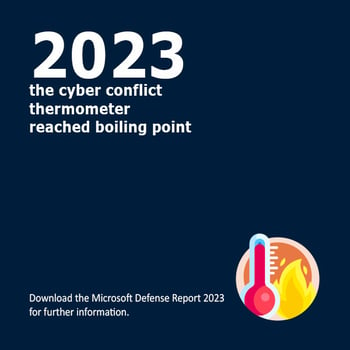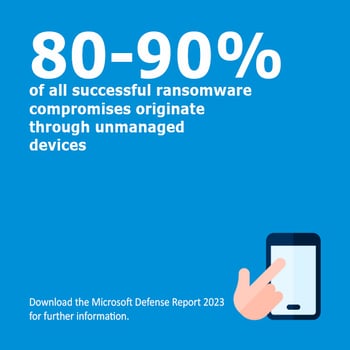Centrality, a trusted partner of Microsoft Solutions and a leading specialist in Microsoft Security, is committed to upholding the highest standards in cybersecurity.
With the aid of Microsoft Cybersecurity Threat Intelligence and The Cybersecurity Tech Accord, we work tirelessly to provide expert guidance, clarity, and assistance in ensuring the utmost security for our users and customers.
Alongside a strong focus on cybersecurity principles, Centrality stands at the forefront of protecting sensitive information and defending against cyber threats. By partnering with industry leaders and like-minded organisations, we leverage collective knowledge and expertise to enhance cybersecurity measures worldwide.
We strive to provide expert guidance, clarity, and assistance in ensuring the utmost security, through adopting these key principles;
- Better Defence: We will protect all of our users and customers everywhere.
- No Offence: We will oppose cyberattacks on innocent people and companies from anywhere.
- Capacity building: We will help empower users, customers, and developers to strengthen cybersecurity protection.
- Collective action: We will partner with each other and like minded groups to enhance cybersecurity.
Today, we will delve into the 8 most prevalent causes of data breaches in an organisations' network and data security. We’ll explore the vulnerabilities that can compromise the integrity of valuable sensitive information. By the end we hope to have equipped you with the knowledge necessary to fortify your digital defences and improve the security measures you take within your organisation.
8 most common causes of a data breach
- Weak or stolen credentials:

When passwords or login information are compromised, most commonly due to poor password management practices, it can lead to unauthorised access and potential security breaches. This underscores the importance of implementing robust password policies, utilising strong and unique passwords, regularly updating them, and utilising multi-factor authentication for an extra layer of protection.
By adopting proactive password management measures, individuals and companies can effectively safeguard their sensitive data and prevent unauthorised access.
- Phishing attacks:
Phishing attacks are deceptive emails or messages, which contain carefully crafted communication attempts aimed at tricking users into divulging sensitive data, such as their personal account information, social security numbers, bank account details or other confidential credentials.
These fraudulent techniques employ various social engineering tactics to manipulate unsuspecting individuals into unwittingly compromising their security.
It is crucial to remain vigilant and exercise caution when encountering suspicious emails or messages to ensure personal information is continuously safeguarded whilst also protecting you or your organisation from potential cyber threats.
- Social engineering:
Cyber criminals often employ deceptive tactics, such as manipulation techniques, to coax individuals into divulging sensitive and confidential information. This can include the act of encouraging the sharing of strong passwords, which can lead to unauthorised access and potential security breaches.
It is critical to remain vigilant and cautious in order to protect your personal and confidential data from falling into the wrong hands.
- Malware and ransomware:
Malicious software, commonly referred to as malware, poses a perilous threat to diverse systems, ranging from mobile devices to intricate data stores. It infiltrates these systems, with the sole malicious intent of encrypting sensitive data or surreptitiously extracting it, leading to consequential harm and severe disruptions of vital security measures.
This persistent and growing menace is a pressing concern for system administrators that requires proactive measures to safeguard against its detrimental and damaging effects.
- Insider threats:
Accidental or intentional data breaches, which can arise from the actions of employees or contractors, are a pressing concern in today's digital landscape. It is worth noting that these breaches are frequently accidental and non-malicious, resulting from a lack of awareness or inadequate training in handling sensitive information.
Addressing this issue through comprehensive awareness programs and robust training initiatives can significantly mitigate the risks associated with data breaches and safeguard valuable data assets.
- Third-party vulnerabilities
This specifically relates to the weaknesses that may emerge from systems or software provided by external vendors. Such vulnerabilities can result in substantial risks to the security and integrity of an organisation's infrastructure.
It is crucial for organisations and companies to conduct thorough assessments and implement effective measures to mitigate potential threats and safeguard their valuable assets.
By diligently evaluating and addressing these vulnerabilities at the outset, organisations can better ensure the long-term protection of their critical systems and data.
By understanding and addressing these weaknesses, organisations can strengthen their overall security posture and ensure the protection of sensitive data and resources.
- Misconfigured or insecure databases:
Improperly configured or unprotected databases without the necessary security measures might inadvertently expose confidential information to unauthorised access.
For instance, a common practice among companies is assigning all employees with ‘Admin’ or ‘Super Admin’ rights instead of assigning appropriate levels for each department.
This practice can pose a significant risk to data privacy and integrity, potentially resulting in serious consequences such as data breaches and compromised systems.
Prioritising database security is crucial to ensure the confidentiality and protection of valuable information.
- Physical theft or loss:

Theft or loss of devices, like laptops, smartphones, and other mobile devices, which may contain sensitive data, poses a considerable risk.
It is crucial to proactively address these vulnerabilities and then implement robust security measures to safeguard against potential data breaches when this occurs.
Having a standard procedure to remotely shut down devices or ‘lock out’ unauthorised users when this occurs can ensure the protection of confidential information and maintain the trust of customers and stakeholders.
What is a cyber security data breach?
So, to give this all some context, a cybersecurity breach is any unauthorised access to, or manipulation of, sensitive data or operating systems. It can involve accessing sensitive personal data without permission, or the theft of financial information. In these terms also think of your credit card numbers, customer data or identity theft.
Breaches occur in multiple ways, as we’ve highlighted, all with the purpose of stealing data or confidential information for financial, political or commercial gain.
The consequences of a cybersecurity breach can be far-reaching and devastating; from damage to reputation and customer trust to significant losses in revenue. Recent high-profile breaches have resulted in significant financial implications for the organisations involved.
How do I protect my organisation from a breach?
To prevent cyber breaches in your organisation you must ensure your computer or network systems are regularly updated with the latest security patches. You must also ensure you have proper access controls in place in terms of user accounts and strong password protocols to protect them from falling victim of a ransomware attack or data leak.
Your company should employ proactive measures such as continuous network monitoring and comprehensive security testing to quickly identify any irregularity or unauthorised access attempts. This includes monitoring system logs, analysing network traffic patterns, and conducting vulnerability assessments to ensure robust protection.
Additionally, it is crucial for you to closely monitor user behaviour and activity, looking out for any signs of anomalous actions or indicators of malicious intent. You should also provide comprehensive cybersecurity training for employees and conduct regular security assessments.
Breaches are typically conducted by "threat actors" who generally belong to one of five groups, as identified by Microsoft.
- Nation-state actors are cyber operators who act on behalf of or are directed by a nation/state-aligned program, regardless of whether the objective is espionage, financial gain, or retribution.
- Financially motivated actors are cyber campaigns or groups, typically driven by criminal organisations or individuals and their aim is to achieve financial gains that cannot be definitively linked with a recognized non-nation state or commercial entity.
- Cyber mercenaries or private sector offensive actors are legitimate legal entities that specialise in the creation and sale of cyberweapons. These cyberweapons are customised to target specific individuals or organisations, as chosen by the customers. Such expertise is in high demand, making these entities important players in the cyber landscape.
- Influence operations are manipulative information campaigns that are communicated online or offline. These campaigns employ various tactics to deceive and manipulate the target audience. It is crucial to be aware of these campaigns and their intentions to protect oneself from falling victim to misinformation.
- Groups in development is a temporary designation given to an unknown, emerging, or developing threat activity. This allows Microsoft to track it as a discrete set of information until we can reach high confidence about the origin or identity of the actor behind the operation.
Given the escalating complexity, scale, and volume of threats, it is imperative that we all swiftly and clearly comprehend threats and their potential objectives and identify them in a common language.
In Summary
To effectively protect your company or organisation from the the most common causes of a data breach, it is crucial to adopt a proactive approach. This includes implementing comprehensive staff training programs to raise awareness and promote adherence to robust security protocols.
Additionally, it is essential to stay vigilant by regularly keeping up with patches and updates across your entire IT infrastructure. If managing these tasks seems overwhelming, consider seeking the expertise of a trusted Microsoft Security specialist partner, such as Centrality.
We have the knowledge and experience to ensure comprehensive protection of your valuable data. By adopting and prioritising these measures, you can significantly reduce the risk of harmful breaches and strengthen your organisation's overall security, reducing the likelihood of major security incidents, repeated cyber attacks, data theft and compromise of information security.
Get in touch with one of our it security experts today, or visit our cyber security for IT web page to find out more.
Download the Microsoft Defence Report 2023
You can download the Microsoft Defence Report 2023, here.


